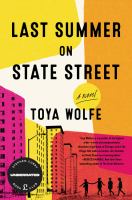Today the Matchmakers welcome guest blogger Michele Hirschfeld! Michele writes:
Last Summer on State Street, the 2022 debut novel by Toya Wolfe, describes the summer of 1999 as four friends experience the dismantling of their girlhood and neighborhood. I love coming-of-age stories written for adults, and this one was outstanding. Authentic and immersive, it brought me back to those qualities of childhood  that transcend time and place, while also vividly bringing to life a world so unfamiliar to many.
that transcend time and place, while also vividly bringing to life a world so unfamiliar to many.
Toya Wolfe grew up in Chicago’s Robert Taylor Homes, high-rise buildings slated for demolition starting in 1999. Described as a Jim-Crow housing project, they were the largest and most disreputable in the nation. In describing a neighborhood that has been previously defined only by its pathologies, the author of this exquisite debut balances the raw dangers of gangs, drugs, and that which lurks in darkened corners, with the playful delight and curiosity of unblemished childhood and the caring adults who watch out for their neighbors. Fe Fe, the narrator, is fortunate to have a savvy and engaged mother, but it isn’t enough to safeguard her brother from gang initiation. Her friends are Precious, a preacher’s daughter; Stacia, the daughter of a gang queenpin; and a newcomer named Tonya, whose unfolding story proves to be the most complicated and tragic of all. But what transcends all is the message of hope and Fe Fe’s enduring love for the imperfect world she eventually left behind.
As I read this remarkable novel I was reminded of a non-fiction book titled There are No Children Here: The Story of Two Boys Growing Up in The Other America, by acclaimed journalist Alex Kotlowitz. This is a heartbreaking and beautifully narrated biography of two Black boys, Lafeyette and his younger brother Pharoah, navigating their childhoods through the neglected and crime-ridden streets of Chicago’s Henry Horner Homes projects in the years 1987 to 1989. I highly recommend both of these works as a way of understanding the injustices and human costs of a life of inner-city poverty, as well as the struggles to adapt and survive.
